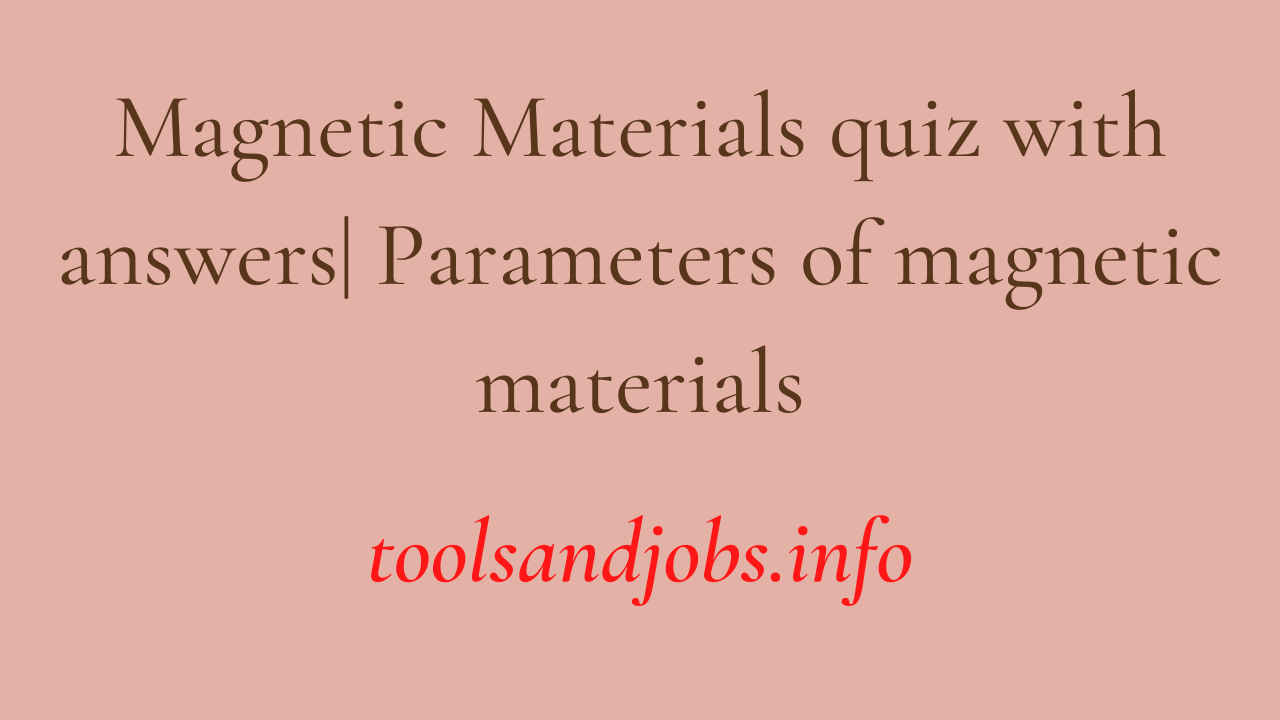This sets of mcq contains objectives on magnetic materials, parameters of magnetic material, Magnetic Susceptibility, Diamagnetism, Paramagnetism, Ferromagnetism, Ferri-magnetism, Ferro-magnetic, Curie-Weiss law, Magnetostriction and more in part 3...
Click to read part 1 of magnetic materials mcq
Click to read part 2 of magnetic materials mcq
SET 1 of magnetic materials mcq's
1. The susceptibility of a diamagnetic material is near about
A. 105
B. 107
C. -10-5
D. 10-5
Answer C
Marks 1
2. Diamagnetism occurs in compliance with
A. Lenz's law
B. Ampere's law
C. Newton's law
D. none of these
Answer A
Marks 1
3. Curie-Weiss law is
A. χ m = C/T
B. χ m = C/θ
C. χ m = C /(T-θ)
D. χ m=C/(θ-T)
Answer C
Marks 1
4. Permanent dipole moment consists of the following angular momentum
A. orbital angular momentum of electron
B. electron spin angular momentum
C. nuclear spin angular momentum
D. all of them
Answer D
Marks 1
5. Each ferromagnetic material has a characteristic temperature above which its properties are vitally different from those below it. This temperature is called
A. Demagnetization temperature
B. Curie temperature
C. Transition temperature
D. Faraday’s temperature.
Answer B
Marks 1
6. For a ferromagnetic material, if θ is the paramagnetic curie temperature, then the relation of susceeptibility χ with Curie constant C
A. χ = C/T
B. χ = C/(T-θ)
C. χ = C(T-θ)
D. χ = C (θ – T)
Answer B
Marks 1
7. For paramagnetic materials, the relative magnetic permeability µr at room temperature is near
A. 1
B. 10
C. zero
D. 1/10.
Answer A
Marks 1
8. The ferromagnetic Curie temperature in degrees absolute for nickel is
A. 631
B. 1043
C. 990
D. 361
Answer A
Marks 1
9. Relative permeability µr for pure iron is
A. 1000
B. 3000
C. 5000
D. 7000
Answer C
Marks 1
10. The following material is used for making permanent magnets
A. platinum cobalt
B. Alnico V
C. carbon steel
D. all of these
Answer D
Marks 1
SET 2 of magnetic materials mcq's
11. The converse of magnetostriction effect is
A. Thompson effect
B. Villari effect
C. Curie effect
D. Bitter powder effect.
Answer B
Marks 1
12. Magnetostriction is the phenomenon
A. of producing electricity in ferromgnetic materials
B. of producing magnetism in conductors
C. of changes in permeability of ferromagnetic material during magnetization
D. of changes in physical dimensions of ferromagnetic materials during magnetization
Answer D
Marks 1
13. Magnetostriction effect is negative in
A. Nickel
B. cobalt
C. both nickel and cobalt
D. none of these
Answer C
Marks 1
14. The temperature below which certain materials are antiferromagnetic and above which they are paramagnetic is called
A. Curie temperature
B. Neel temperature
C. Transition temperature
D. Weiss temperature
Answer B
Marks 1
15. Magnetostriction is…
A. induced magnetism
B. volume changes accompanying magnetization
C. rate of magnetization
D. rate of loss of magnetization
Answer B
Marks 1
16. For which of the following materials the net magnetic moment is zero?
A. ferromagnetic materials
B. paramagnetic materials
C. antiferromagnetic materials
D. ferrimagnetic materials
Answer C
Marks 1
17. ferrites are….
A. not easily machinable
B. hard materials
C. brittle materials
D. materials possessing all of the above properties
Answer D
Marks 1
18. Bohr magneton is a unit of
A. magnetic energy
B. magnetic moment.
C. polarizability
D. hysteresis loss
Answer B
Marks 1
19. The magnetic field required to reduce the residual magnetization to zero is called
A. retentivity
B. coercivity
C. hysteresis
D. saturation magnetisation
Answer B
Marks 1
20. What is the material with equal, anti parallel atomic magnetic moments known as _____________
A. Ferrimagnetic
B. Ferrite
C. Ferromagnetic
D. Anti ferromagnetic
Answer D
Marks 1
SET 3 of magnetic materials mcq's
21. Metallic copper is
A. paramagnetic substance
B. diamagnetic substance
C. ferromagnetic substance
D. ferrimagnetic substance
Answer B
Marks 1
22. Which one of the following has maximum permeability?
A. grain oriented Si steel
B. 4% Si steel
C. pure iron
D. none of these
Answer A
Marks 1
23. The hysteresis loop for material of transformer core should be
A. short and narrow
B. tall and narrow
C. short and wide
D. tall and wide
Answer B
Marks 1
24. The change in dimensions during the process of magnetizations termed as
A. skin effect
B. magnetostriction
C. hall effect
D. peltrs effect
Answer B
Marks 1
25. Area of hysteresis loop represents
A. copper loss
B. eddy current loss
C. hysteresis loss
D. iron loss
Answer C
Marks 1
26. For a magnetic material, magnetic field density (B) & magnetic field intensity (H) given as
A. B α H
B. B α 1/H
C. H α B
D. H α 1/B
Answer A
Marks 1
27. The magnetic flux density B is given as_________ Where Φ= magnetic flux; A= Area.
A. B=Φ/A
B. B=A/Φ
C. B=Φ×A
D. None of this
Answer A
Marks 1
28. The magnetic field strength required to reduce the residual magnetization to zero is called
A. retentivity
B. coercivity
C. hysteresis
D. saturation magnetization
Answer B
Marks 1
29. The curie temperature of iron is
A. 1035 K
B. 1400 K
C. 1500 K
D. 1200 K
Answer A
Marks 1
30. Example for soft magnet
A. 45 Permalloy
B. CrO2
C. Fe-Pd
D. Alnico
Answer A
Marks 1
Click to read part 1 of magnetic materials mcq
Click to read part 2 of magnetic materials mcq


